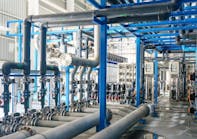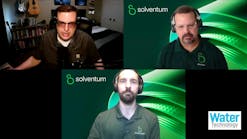Q
What kind of easy to use water test kits are available that I can use so that I can get fast results at a low cost? – U.S.
A
Providers of water services always need water quality data to evaluate the type of contamination problem they are facing, be it hardness, corrosion or microbes, to select the types of technical interventions that might be needed. There are many test kits on the market that provide good estimates of concentrations of many kinds of water parameters and contaminants. They are inexpensive and easy to use with some practice, and do not require the expertise of an analytical chemist or microbiologist, or an expensive fixed laboratory. Many can be run in the field. They always require care and cleanliness and good practices and carefully following the directions, so as to produce reliable results.
Parameters and circumstances that require an expert analytical laboratory
Of course, many analyses require complex equipment and a qualified analytical laboratory. Some examples include trace organic chemicals like THMs or pesticides, many inorganic chemicals and more complex microbial analyses like for giardia or Cryptosporidium protozoa. These could cost hundreds of dollars per sample and may require days or weeks before the results are provided. Virtually all analyses that will be used for official standards and regulatory compliance determinations will require data from a state certified laboratory. So, for example, data from public water systems to determine official compliance with chemical and microbial drinking water regulations all fall into that category. Except for standard inexpensive microbial analyses like coliform bacteria they are usually required infrequently. The good news is that there are many simpler analyses for some of the substances that even public water systems can use for tracking treatment processes and day-to-day performance.
Parameters that can be tested with kits
This is not an exhaustive list but it gives an overview of the types of kits that are available and sources of many of them. Some of these involve use of a meter and others are color or other simple tests. Among the general water parameters that can readily be tested are: pH, turbidity, temperature, alkalinity, conductivity, hardness or total dissolved solids. Chemical tests include: Chloride; free, total and combined chlorine; chlorine dioxide; chromium VI; copper; arsenic; fluoride; iron; lead; manganese; nitrate; nitrite; nickel; phenols, phosphate; sulfide; sulfite; and sulfate. Simple microbial tests include: Fecal and total coliforms; E. coli, and fecal streptococci. Some basic examples of these methods and products are described below. Many more are available in the catalogues of the various suppliers.
General parameters
Alkalinity: Available simple kits can measure alkalinity on site as calcium carbonate. Some use a small direct reading titrator. Testing ranges are about 0-200 ppm with sensitivity ~4 ppm as CaCO3. Costs for 50 tests are about $35.
pH: The measurement of pH should be done in the field rather than by taking a sample to a laboratory, because pH will change by exposure to the atmosphere, such as by losing or picking up carbon dioxide. There are battery operated pH meters suitable for field use that cost several hundred dollars each, but they can measure hundreds of samples.
Meters provide a precise measurement, but there are simpler and much less expensive ways of obtaining a very good estimate of pH. Simple litmus paper gives a quick indication of acidity or basicity. Hydrion or Universal pH paper is available at very low cost (a few cents per test) from many sources. Dipping a small strip of the paper in the water produces a color indicating the approximate pH that can be read off of a color chart.
Hardness: There are kits capable of measuring calcium hardness as calcium carbonate on site. Their performance is in the typical drinking concentration range as well as above by dilution of the sample. Cost is about $50 for a kit that can perform 50 tests.
Temperature: Water temperature is easily measured with numerous standard thermometers, but digital readout devices are also available.
Inorganic chemicals
Arsenic: Several arsenic test kits are available that will measure arsenic +3 and arsenic +5 in the low ppb range. A common technique involves adding reagents to a water sample that results in color formation on a test strip. Some tests require about 15 minutes for color production. The color on the strip is compared to a color chart to determine the concentration of total arsenic. Costs are typically about $175 to $200 for 50 samples.
Chloride: Kits for on-site chloride in fresh water samples are available using a direct reading titrator. Costs are about $50 for 50 tests.
Chlorine: There are free, total and combined chlorine test kits available from several suppliers that can quickly measure on site the three chlorine disinfection species in the range of typical drinking water concentrations. Two reagents are added to a water sample and the color formation is measured with a color comparator. Cost is about $65 for a kit that can perform 50 tests.
Copper: Copper test strips are available to measure total copper levels from 0 to 3 ppm in seconds. Colorimeter tests are available with greater precision and accuracy.
Iron: Numerous low cost field test kits are available for iron in the drinking water concentration range from about 0.5 ppm to 10 ppm. The simplest kits involve color generation with a reagent and comparison with a color chart.
Nitrate-nitrogen: Several low cost test kits are available for this important water quality parameter. They usually involve adding a solid reagent to the water in a vial and then allowing the color to develop, then inserting the vial in a color comparator.
Microbial indicators
The traditional testing for microbial indicators like coliforms once required a microbiology laboratory facility and trained microbiology technicians or microbiologists along with sample preparation equipment, and glassware and growth media and autoclaves for sterilization and temperature controlled ovens. That is no longer the case. There are now techniques available that do not require special equipment or special training beyond some basic instruction. For total coliforms and E.coli the original new test was Colilert, but numerous variants are now also available. As a presence-absence test it involves adding a special solid reagent to the water sample and storing it for 18 to 24 hours at 98o F. If a yellow color develops, that indicates total coliform bacteria. If the same tube fluoresces when a UV light is shined on it that indicates the presence of E.coli. So, two important microorganisms are identified in one test in 24 hours or less with minimal facilities. The method is also amenable to multiple tube most probable number quantitations if the sample is diluted, divided and incubated. When purchased in bulk the unit costs can be in the area of $5 or $6 including sterilized containers and the reagent. Similar tests are available for enterococci and pseudomonas.
There are other simple and low cost systems available for heterotrophic, sulfate reducing, iron and pseudomonas bacteria. One group is called biological activity reaction test (BART) systems and they are available from several suppliers. All of these microorganisms can be problematic in water systems and plumbing and their identification facilitates selection and application of corrective actions.
Additional options
There are a multitude of tests that are available when a battery operated pocket colorimeter is available. They range from several pesticides and metals like lead, iron, copper and manganese to fluoride, nitrate, phosphate and sulfate, and others. The cost of the package that includes the colorimeter and the required regents for each analyte starts at about $400 for each analyte and can exceed $1,000 in some cases. However, the supplied reagents package can often provide more than 100 tests and the colorimeter continues to be usable for subsequent testing with other analytes and additional purchased reagents that are significantly less expensive than the colorimeter. Again, the unit costs are in the few dollars per test range when a large number of tests will be needed.
Conclusion
There are numerous easy to use test systems that can be used by providers of water services to obtain good estimates of the presence and concentrations of many water contaminants. Many are very low cost and amenable to use on site and they provide very rapid results. They do not require expensive equipment or extensive training, but operating directions should be carefully followed. This summary has concentrated on the simpler and lower cost field test kits, however, there are many others that utilize spectrophotometers and other instruments, some of which are portable. Those instrument costs could be in the hundreds or thousands of dollars, however, numerous types of color generating chemicals can be measured using the same spectrophotometer. So, as the breadth of the desired testing and number of samples to be tested increases, a more developed small laboratory environment with appropriate personnel training would become more desirable as more complex analytical methods are selected. Accuracy and precision of testing would also be improved. Unit costs might become lower in the long run with better instrumentation for some parameters, but the on-site testing capabilities with simple kits still has important benefits, and extremely accurate results are not always necessary to make the appropriate water treatment decision in many applications.
For more information on testing kit manufacturers, visit https://www.watertechonline.com/directories/4627-buyer-s-guide/topic/10494-testing-kits.
_________________________________________________________________________________________________________________________________
Dr. Cotruvo is president of Joseph Cotruvo and Associates, LLC, Water, Environment and Public Health Consultants. He is a former director of the U.S. EPA Drinking Water Standards Division.

